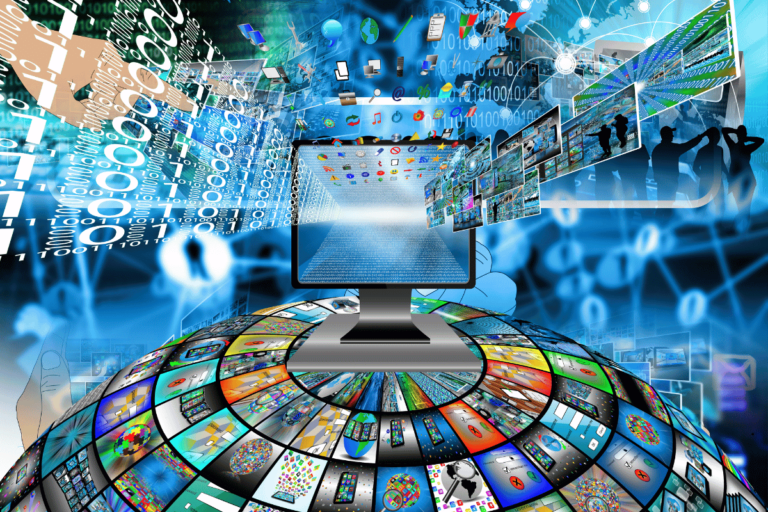5G Expansion: The rollout and implications of 5G technology.
Did you know that 5G wireless networks have been growing fast since 2019? Now, 62% of smartphones support 5G. Companies like Verizon, Google, and AT&T are bringing 5G to homes and businesses. This change is big for the tech world and is starting a new wireless era.
Key Takeaways:
- 5G networks have rapidly expanded since their rollout in 2019.
- 62% of smartphones now come with 5G connectivity.
- Popular ISPs like Verizon, Google, and AT&T offer 5G connectivity to homes and businesses.
- 5G technology offers faster download and upload speeds, improved latency, better bandwidth, and smaller physical footprint compared to previous generations.
- 5G has transformative potential for applications like AI, ML, IoT, and smart cities.
How Does 5G Work?
5G technology is the next big thing in cellular networks. It uses radio waves to send data faster and more reliably than before. This means faster download and upload speeds, changing how we connect online.
5G networks are made up of “cells” that work together. Each cell has 5G antennas and base stations. These help devices connect to the internet using radio waves. As you move, you switch from one cell to another without losing connection, making sure you stay online without interruption.
5G is super fast, with speeds up to 10 or 20 gigabits per second. That’s over 100 times quicker than 4G. This means websites load faster, videos stream smoothly, and big files download quicker.
5G is also great because it has low latency. Latency is how long it takes for data to go from your device to the network. With 5G, this time is cut down, making things like gaming, virtual reality, and online doctor visits better. You get to react faster and have a more real-time experience.
5G can handle more devices and data at once thanks to its high throughput. This is important as more devices connect to the internet and the Internet of Things (IoT) grows. It means more devices can work together smoothly.
5G also has a wider bandwidth, which helps it perform better. Bandwidth is the range of frequencies used for data. A wider range means more data can be sent at once, reducing delays and making connections more reliable.
img src=”https://seowriting.ai/32_6.png” alt=”5G technology” align=”center”>
In short, 5G changes the game with its fast speeds, low delays, high capacity, and wide bandwidth. It opens up new possibilities for real-time communication, immersive experiences, and connecting many devices together. As 5G grows, we’ll see how it changes industries and our daily lives.
Key Differences Between 5G and Previous Generations
5G technology stands out from its predecessors in several ways. These changes make 5G networks faster and more efficient.
1. Size and Power:
5G transmitters and cells are smaller and use less power than older networks. This makes them easier to set up in cities and improves coverage in hard-to-reach areas.
2. Modulation and Coding Scheme:
5G’s adaptive Modulation and Coding Scheme is a big leap forward. It adjusts how data is sent and received on the fly. This means 5G networks can send data faster and with fewer errors, making it more reliable.
3. Frequencies:
5G uses a wide range of frequencies, including low, mid, and high bands. This lets 5G handle more devices at once, meeting the needs of the Internet of Things (IoT).
4. Low Latency:
5G’s big win is its low latency. Latency is the delay in sending and receiving data. 5G cuts this delay, making data transfer almost instant. This is great for things like self-driving cars and remote surgeries.
Let’s look at file downloads and cloud work. Before 5G, these tasks took a long time because of high latency. But with 5G, they’re much quicker, making our work more efficient.
These differences show how much 5G has advanced over older technologies. It’s smaller, more efficient, and faster, setting the stage for a new era of connectivity.
The Implications of 5G in Healthcare
5G technology is changing healthcare, making it better for patients and improving results. It brings many benefits like low latency, high speed, and reliable connections to healthcare.
5G lets us connect and manage lots of IoT devices easily. These devices help monitor patients from afar, track their health, and make sure they take their medicine. With 5G, doctors can quickly check this data and make important decisions to help patients.
In emergencies, 5G’s speed and reliability are key. It lets doctors get critical patient info fast. This means they can act quickly, which can save lives and improve care.
5G also makes sending HD photos and videos easy. Doctors can share X-rays and mammograms without moving them physically. This helps with faster diagnosis and treatment.
5G also changes how we do telemedicine and virtual healthcare. It lets doctors do virtual visits, check on patients remotely, and give them personalized care plans. This helps bring medical help to places that don’t have it now.
5G is a big deal for healthcare innovation. It makes IoT devices work better, gives doctors real-time data, sends HD images, and boosts telemedicine. With 5G, healthcare is set for big changes, making patient care better and improving results.
- Improved patient care
- Real-time access to vital patient data
- Efficient remote patient monitoring
- Enhanced medical imaging and diagnosis
- Expanded telemedicine capabilities
5G and Supply Chain Optimization
Supply chains are key to the global economy, making sure products get to consumers fast. As industries go digital and automate, making supply chains better is more important than ever. That’s where 5G technology steps in, changing how supply chains work.
5G’s fast data transfer lets supply chains send lots of data quickly. This means supply chain managers can make quick, smart choices. This leads to better efficiency and lower costs.
Using 5G, supply chains can get even more digital. IoT devices can connect easily, track inventory, check quality, and make sure deliveries are on time. This automation cuts down on human mistakes and makes things run smoother.
5G isn’t just about making things faster and more efficient. It also makes supply chains more secure. The secure connections of 5G keep important data safe from cyber threats.
Also, 5G lets us use cool tech like cashless payments and HD cameras and drones for managing stock. These tools help remove supply chain bottlenecks. This means operations get faster and more precise.
In summary, 5G technology is a big deal for improving supply chains. It brings fast data transfer, more digitization, automation, and better security. This means supply chains can work better, cost less, and run smoothly in our connected world.
5G and Smart Cities
5G technology is changing how cities work and making them smarter. It helps with traffic flow and air quality, among other things.
5G supports advanced AI systems in smart cities. This lets cities use data and real-time info to make better decisions.
IoT sensors are key for smart cities. With 5G, they send data faster and more efficiently. This helps city officials manage urban life better.
Traffic is a big issue in crowded cities. 5G helps by letting IoT sensors track traffic patterns. This leads to less congestion and better mobility for everyone.
5G also helps with air quality. Sensors monitor pollution levels. Officials can then take steps to reduce pollution, making cities healthier.
AI chatbots powered by 5G make city services better. People can talk to these chatbots for info or help. They work all the time, making citizens happier.
Key points:
- 5G technology enables the development of smart cities.
- AI capabilities empowered by 5G contribute to data-driven decision making.
- IoT sensors connected through 5G facilitate real-time data collection and analysis.
- 5G helps optimize traffic flow and reduce congestion in urban areas.
- Smart cities powered by 5G can improve air quality and environmental sustainability.
- AI chatbots powered by 5G enhance the efficiency of city services and citizen engagement.
5G technology is bringing big changes to smart cities. It’s all about making cities more innovative and sustainable for the future.
Conclusion
5G technology has brought us into a new era of fast and reliable connectivity. It offers speeds that are much faster, with low delays and high reliability. This means new possibilities across many industries.
The economic benefits of 5G are huge, expected to hit $13.2 trillion by 2035. It will create millions of jobs worldwide in the 5G industry.
5G is changing how we talk and use technology globally. It’s making healthcare, supply chains, and cities smarter. This leads to better efficiency and quality of life.
This tech advancement could open up huge economic chances and support sustainable growth.
5G networks are changing businesses and helping people and communities. They’re closing the gap in internet access, making sure everyone can use high-speed internet. This means more collaboration, innovation, and sharing of knowledge on a big scale.
As we see 5G grow, it’s clear it’s more than just making internet faster. It’s changing the future of tech and communication. 5G is leading us to a more connected, efficient, and inclusive world.







